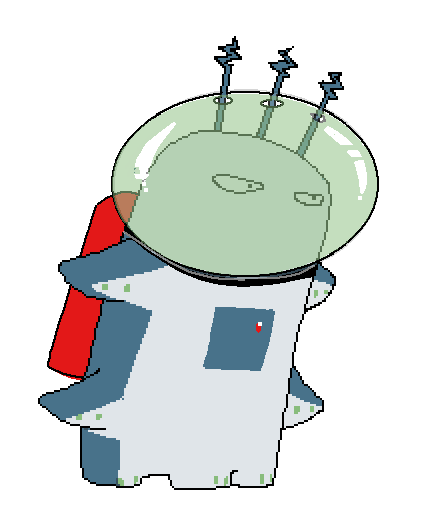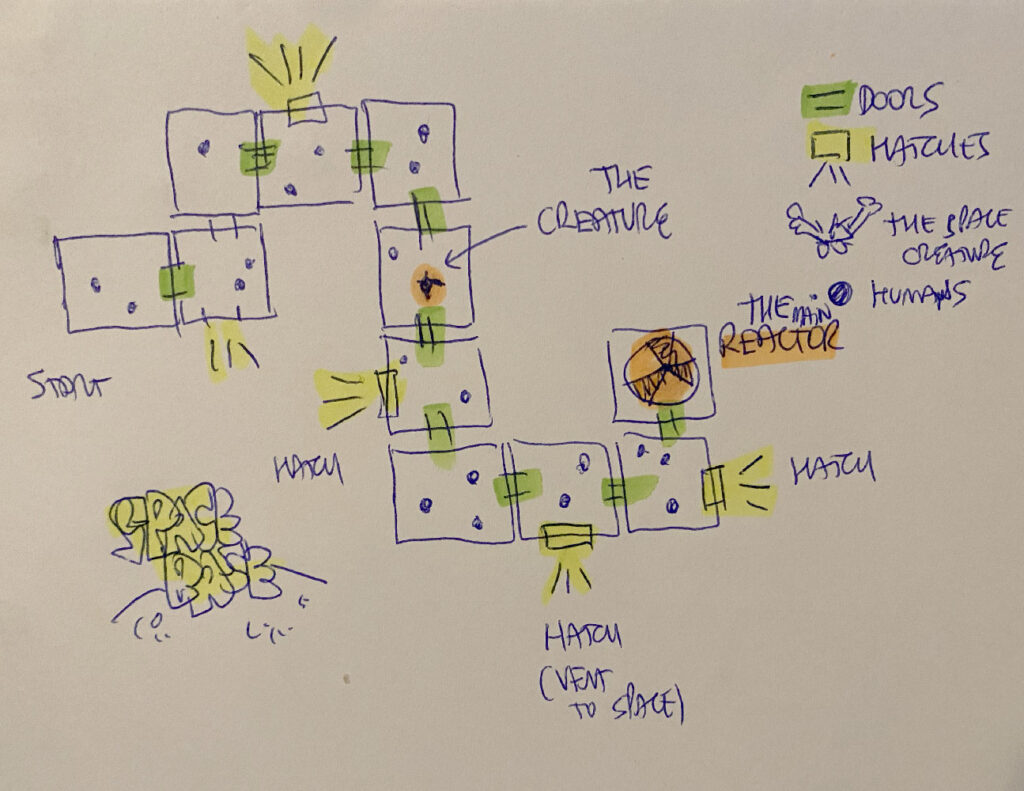
When I first started planning the main guidelines of this new project, I missed one of the most critical requirements for the assignment: the game’s mechanics must include some innovation or unique element. What a plot twist! Realizing this caused me to rethink the whole concept for several days because my plan was everything but original… until now!
Back to the drawing board
At the point of discarding it and considering other ideas, it occurred to me that I could modify how the player would relate to this game so that instead of controlling the ‘space beast,’ why not control the complete lunar base itself?
With this in mind, I started to think about the main functions of such a complex structure: probably the most important ones would be related to ensuring human habitability. For example, the Moon station’s AI can take care of the well-being of its occupants, provide water and oxygen, protect against cosmic rays, control the entrances and exits to the exterior through the appropriate pressurization systems, things like that.
Of all these possible functionalities, the one that most interested me was the latter, since, if the player could control the flow of the inhabitants inside the base, he would also have some chance of preventing the space creature from reaching its target (remember that the alien is trapped in the base and is attracted by the radiation sources it needs to survive, being its ultimate goal to immolate itself in the nuclear reactor that keeps the whole base alive).
If the player could control the entrances and exits of the different rooms and corridors that make up the base, and at the same time also have control over the airlocks that separate the walls of the space station from the vacuum, there would be chances of being able to expel the creature into space – or rather into the lunar soil, and thus end this threat- but at the same time we will have to be careful not to kill civilians or members of the security forces of the station when these hatches vent the atmosphere of the base.
These new ideas are already getting me excited to start testing new prototypes.
Additional challenges
There are more than a few doubts that plague me, however:
- Should the doors connecting the rooms open and close in a coordinated manner ?. Either independently of each other or all together (or by sector or from room to room).
- Can the airlocks be open and closed at will, or once activated there is no reverse?
- Will the expulsion of the atmosphere be immediate or gradual? Will this provide any chance of escape for the creature and those around it, or once opened there will not be much more to do?
At the same time, some other technical challenges arised:
I am going to be able to create one or more AI routines for the space creature to make it ‘intelligent’ enough to find its way to the reactor in the most logical way possible -at least from the human player point of view, as the creature’s logic could be quite different from ours!- and to do the same for the characters living on the station so that they are not all trapped in one sector like fools making the player find it impossible to open the airlocks into the void without killing a large number of innocents in the process.
The location of the characters inside the rooms will not be something simple to carry out: I will have to verify that they do it within the limits of the rooms, that they do not generate one on top of the other, that they have an attractive distribution to facilitate the gameplay. The same goes for the airlocks and I will probably have to verify that the rooms are connected in a correct way.

The needs of the many outweigh the needs of the few
With all this new elements I have enough material to set a limit on the scope of this project.
I believe that with them, I fulfill the demanded conditions and at the same time I venture into several problems that I never tried to solve in previous games.
Procedural content generation promises to be a powerful tool for independent game developers, since they do not have to a big budget and a large team of designers, artists and programmers, the automatic creation of content can make them more competitive. (Nwankwo: 2017)
On top of that, the tension that should generate on the player trying to lead the creature through the corridors so that, instead of reaching the reactor, the invader is trapped near an airlock seems to me more than enough as an attraction. It must be clear that there is a limit of acceptable collateral damage (applying the “the needs of the many outweigh the needs of the few”) but it will not be a matter of throwing innocents into space in order to kill the creature. This will be reflected in the game scoreboard and if this limit is exceeded the player will lose the game.
But I am also curious to know if much of the fun will be provided by the simple fact of blowing up soldiers and civilians left and right. I think there is a certain morbid curiosity in seeing how the poor humans will be blown into space that can keep the player entertained for a long time!
The prototypes and the tests I will do with to test this ideas will give me some clues in this regard, I have no doubt.
In the graphic section, the game will have an aesthetic very close to the science fiction films of the 50’s and 60’s with ridiculous space suits, sharp needle-shaped rockets and elements that would be impractical in realistic conditions.
With all this exposed this is the list of steps to follow:
- Generation of the level composed of connected and procedurally generated rooms.
- Incorporation of doors and airlocks (these airlocks can only be placed on the walls of the rooms bordering the lunar surface, not the internal walls).
- Generation of the creature inside the playable zone, as far as possible from the nuclear reactor, creation of an artificial intelligence that allows it to move towards it in a ‘convincing’ way for the player.
- Random incorporation of the occupants of the base (civilians and military).
- Interaction between these characters and the creature (will they run away from it? will they attack it? will they be slaughtered by it on their way?).
- Creation of the functions that allow opening and closing of the doors that connect the different rooms (including the interface for the player).
- The same for the airlocks that connect the base with the lunar void.
- Expulsion to the outside of all those elements that are near these airlocks when activated by the player.
As I said, I think it is an extremely ambitious list. Fortunately, the bibliography I can consult on this subject is also very extensive and there are plenty of examples of all kinds (both in books, magazines and video material). I think I also have enough time to be able to study these problems and propose my solutions in the form of rapid prototypes.
This is a work in progress, more to come soon!
List of figures
Fig 1.
References
Nwankwo G, Sabah M, Fiaidhi J. 2017 ‘Procedural Content Generation for Dynamic Level Design and Difficulty in a 2D Game Using Unity’. International Journal of Multimedia and Ubiquitous Engineering Vol.12, No.9 (2017), pp.41-52
Nystrom R. 2014 ‘Game Programming Patterns’ gameprogrammingpatterns.com
ISBN: 978-0-9905829-2-2